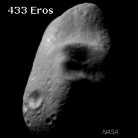
|
|
Experts on Near Earth Objects reported the progress in the search for NEOs and suggested possible future targets to the U.S. House Committee on Science yesterday. Dr Edward J. Weiler, the Associate Administrator for Space Science at NASA, together with Dr. David Morrison, from NASA Ames Research Center, and Dr Brian G. Marsden, the director of the Minor Planet Center, were pleased to report progress in cataloging all NEOs larger than 1 km. NASA had been charged with finding and tracking 90% of the 1000 Near Earth Asteroids larger than 1 km by the U.S. Congress in response to the Spaceguard Survey Report published in 1991. The representatives have reported that 619 of these objects have now been identified and their orbits characterised, over half way to their goal which is due to be complete by 2008.
Weiler explained to the Committee that the Spaceguard Survey was being achieved through NASA funding of six independent research groups, which between them have ten telescopes. Brian Marsden expanded on the organisation of the Survey saying that the LINEAR and NEAT programs, which use USAF telescopes in New Mexico and Hawaii and a telescope on Palomar Mountain in California, together with three other NASA funded programmes, using telescopes in Arizona, are responsible for well over 80% of discoveries. However, Marsden also recognised the contribution of European observatories in following-up the discoveries made by NASA founded programmes.
The next step to take in NEO detection, suggested the experts, would be to attempt to catalogue smaller NEOs. Weiler, suggested that, due to its expertise in space-based efforts, NASA would perhaps not be an appropriate choice for the led organisation for any extended search. The size threshold for smaller NEOs was difficult to identify, said the experts, however, David Morrison suggested the 300 m limit set by the UK Government’s Task Force Report was a reasonable target.
Dr Joseph A. Burns, an astronomer from Cornell University and a member of the Solar System Exploration Survey Committee recommended that the planned Large-aperture Synoptic Survey Telescope (LSST) could make a significant contribution to the discovery of smaller NEOs. The LSST will have a 6.5-m-effective-diameter mirror, and very wide field (~3 deg) of view and produce a digital map of the visible sky every week. Burns said that in the course of its regular work LSST was capable of finding a large proportion of smaller NEOs.
If the search for NEOs is to be extended to the 40,000 objects smaller than 300m further support would be needed for the Minor Planet Center, said Brian Marsden, due to the increase in the number of discoveries and observations. Seeking ways of putting the governance and funding of the Minor Planet Center on a robust international footing was also one of the recommendations of the UK Government’s Task Force Report.
More info: NASA NEO Program
Related News
Morrison on NEOs
|

